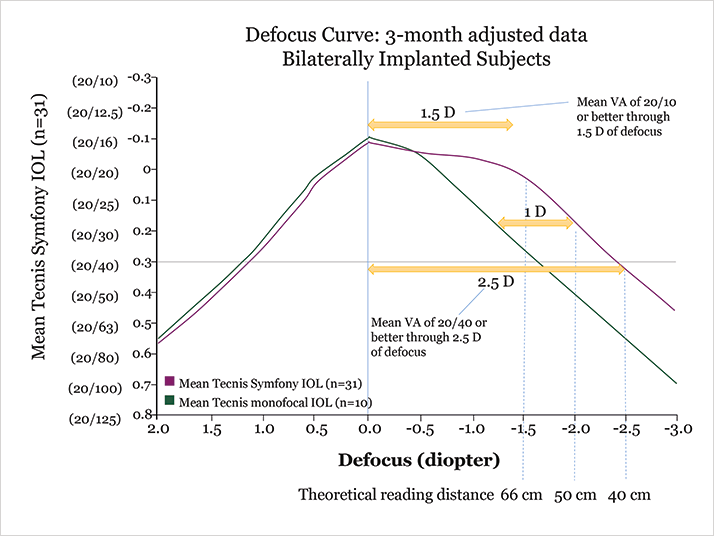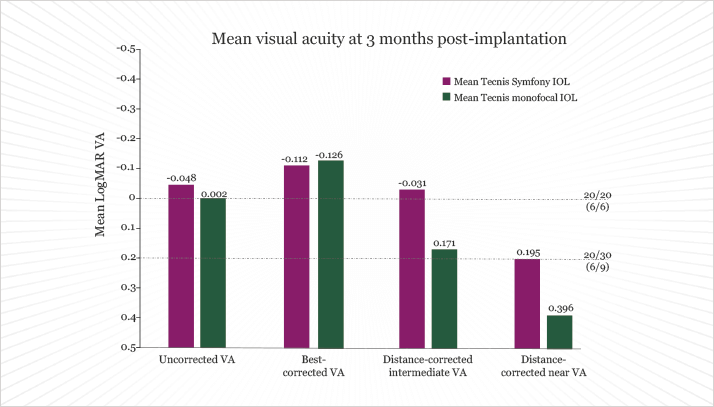
- People purchasing pricey premium IOLs expect perfect vision
- Multifocal IOLs (mIOLs) offer excellent near, intermediate and distance vision, but optical compromises have had to be made to achieve this
- These compromises can bring about optical adverse events (OAEs) – leaving some patients unhappy with their vision
- Presbyopia-correcting design continues to evolve. Can newer optical design approaches minimize OAEs, avoid pupil dependence and fulfil patients’ expectations?
One of the consequences of the great advances in cataract surgery and IOL technology over the last two decades is that many of today’s patients now expect almost perfect vision from a premium IOL. They demand excellent near, intermediate and distance vision, without any of the potential drawbacks like glares, halos or comets. Such patients require an element of expectation management, but will this always be the case? Have presbyopia-correcting IOL designs improved to a stage where it is a realistic expectation that these demands – in particular, good intermediate vision – can be met?
One of the consequences of the great advances in cataract surgery and IOL technology over the last two decades is that many of today’s patients now expect almost perfect vision from a premium IOL. They demand excellent near, intermediate and distance vision, without any of the potential drawbacks like glares, halos or comets. Such patients require an element of expectation management, but will this always be the case? Have presbyopia-correcting IOL designs improved to a stage where it is a realistic expectation that these demands – in particular, good intermediate vision – can be met?
Presbyopia correction: design trends and trade-offs
IOL manufacturers have taken three central approaches to address this. The first, was the development of multifocal IOLs (mIOLs). These typically employ either diffractive or refractive optics, and can produce multiple, simultaneous focal points, which – depending on the design – can give a patient good near and distance vision. The cost of splitting the light like this is that less light reaches the retina for each desired focal plane. Most current mIOLs rely on diffractive optics, with tight concentric rings that diffract light for near vision, rather than refractive optics with differently-powered zones, but there are also some that combine the two in a hybrid approach.One current trend with mIOL is to implant “low add” lenses. In these, the near addition at the lens plane is reduced to around +2.75 or +3.25 D, which translates into a near addition of between +1.75 and +2 D at the spectacle plane. This results in greatly enhanced intermediate vision, but enables the patient to retain good binocular reading function (at a distance of approx. 40 to 50 cm from the eye). mIOL manufacturers have even produced multifocal lenses that have near additions of +1.5 D, in order to maximize visual acuity at intermediate distances. The ability to offer this range of post-surgical outcomes to patients is certainly valuable. The second option is to modify monofocal lenses in a way that generates an extended depth of focus. This can be achieved in various ways, such as changing the asphericity of the lens (as in the case of the Hoya AF-1) or by applying the “micro monovision” principle to cover the entire range from near to distance by inducing anisometropia – one eye receives a near vision IOL, the other a distance vision IOL. This is common practice with contact lens prescriptions, and the potential visual side effects are similar and well-known too, principally blur, fog, glares, halos and reduced night-time vision – and even transient diplopia. Can we do better?
In contrast…
A newer IOL design, termed “Echelette” has further refined and improved what presbyopia-correcting IOLs can offer. Unlike mIOLs that create a fixed number of focal points, the first Echelette-design, the Tecnis Symfony IOL (Abbott Medical Optics), generates a wide focal range, which results in the patient experiencing continuous sharp vision from distance to near over a 1.5 D range as well as a visual acuity of 20/40 (decimal 0.5) or better over a range of even 2.5 D (Figure 1). Mean visual acuity was above 20/20 (decimal 1.0) for far and intermediate distances and 20/30 (decimal 0.67) for near distance, as seen in a recent clinical study (Figure 2).
An extended depth of focus might satisfy some of the expectations from today’s most demanding patients, but they won’t be happy if the visual side-effects are many and noticeable. The Echelette-design provides an almost full chromatic aberration correction, which translates into a good optical quality and excellent Modulation Transfer Function – in other words, contrast is well preserved by this lens. As the Tecnis Symfony is essentially an extended depth of focus evolution of the original monofocal Tecnis IOL, it’s reassuring to see that there is no difference in patient-reported symptoms that are typically associated with mIOLs – like halo and glare.
Dim light and expanding pupils
Presbyopia-correcting IOLs also vary considerably in their dependence on pupil size to function at near distances, and this must be taken into account when deciding which lens is best suited to a given patient. Pupil dependence is a complex issue. While it is a function of optic design, each broad category of optic design contains examples that are pupil-independent and others that are pupil-dependent. Tecnis lenses – both the traditional multifocal and the Echelette extended depth-of-focus design, are pupil-independent, so the quality of near and intermediate vision doesn’t change as the pupil expands in dim light. The Zeiss trifocal lens is also pupil-independent, having both central and peripheral trifocal elements, meaning that it can extend near function with a wide pupil. Apodized lenses, including the ReStor and the MicroF, however, don’t function as well in low light because they direct less light to near vision as the pupil widens. Most patients expect to maintain near function in low light, and pupil-independence is especially important for those who drive a lot at night or whose work or hobbies take place in poorly lit environments. This is another reason why a detailed understanding of a patient’s lifestyle and optical requirements is crucial in choosing the most appropriate lens for them.Today’s patients are more demanding than ever before, with a strong desire for a spectacle-free life. Procedures like LASIK have raised their expectations of having great post-surgical outcomes and becoming spectacle-free afterwards. Historically, it’s been hard for IOLs to fully bridge the gap between near and distant vision – the compromise was always intermediate vision. But there has been a clear trend towards surgical refractive interventions that close that gap and provide better intermediate vision. The new generation of presbyopia-correcting IOLs that offer an extended depth of focus represent a new opportunity to provide an excellent visual quality of vision at all distances, with a greatly reduced incidence of the optical adverse events that have historically been associated with mIOLs. Patients have been demanding it for years; only now are we really in a position to deliver it.
Florian Kretz is an ophthalmologist and Senior Research Specialist at the The International Vision Correction Research Centre (IVCRC) & David J. Apple Laboratory of Ocular Pathology. Gerd Auffarth is the Director of the David J. Apple International Laboratory of Ocular Pathology and IVCRC as well as Chairman of the Department of Ophthalmology, Ruprecht-Karls-University of Heidelberg, Germany.
